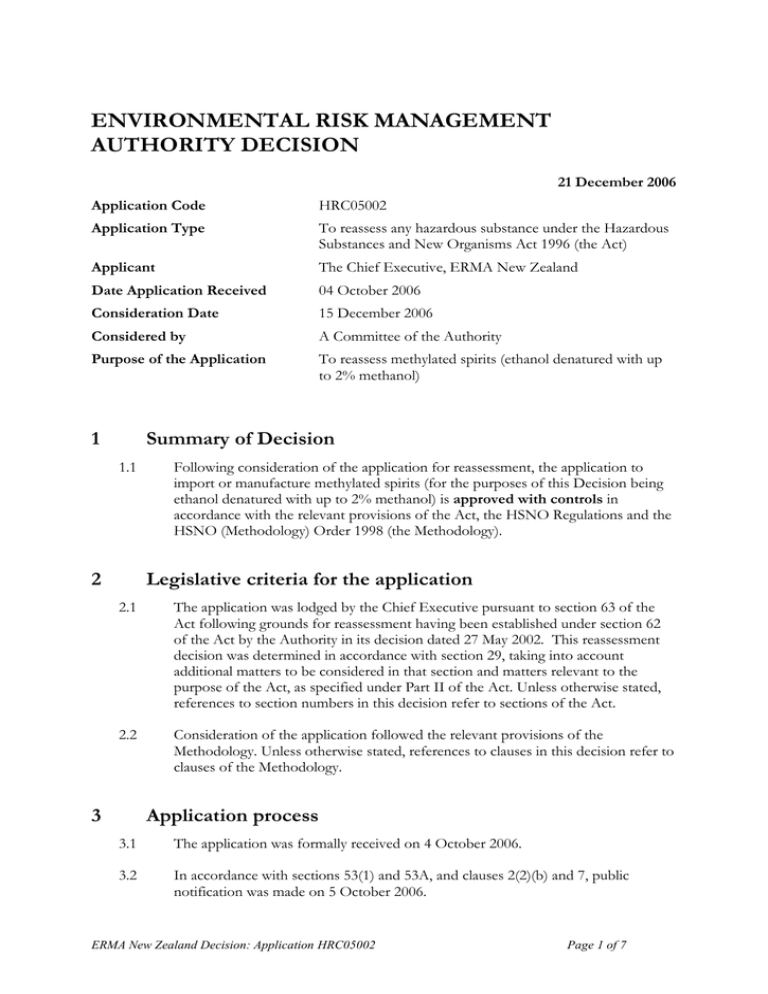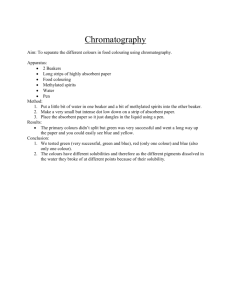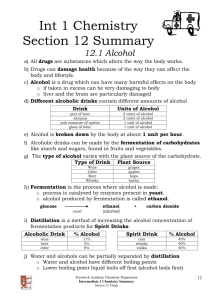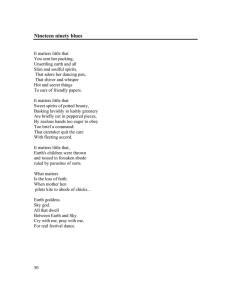ENVIRONMENTAL RISK MANAGEMENT AUTHORITY DECISION
advertisement

ENVIRONMENTAL RISK MANAGEMENT AUTHORITY DECISION 21 December 2006 Application Code HRC05002 Application Type To reassess any hazardous substance under the Hazardous Substances and New Organisms Act 1996 (the Act) Applicant The Chief Executive, ERMA New Zealand Date Application Received 04 October 2006 Consideration Date 15 December 2006 Considered by A Committee of the Authority Purpose of the Application To reassess methylated spirits (ethanol denatured with up to 2% methanol) 1 Summary of Decision 1.1 2 Following consideration of the application for reassessment, the application to import or manufacture methylated spirits (for the purposes of this Decision being ethanol denatured with up to 2% methanol) is approved with controls in accordance with the relevant provisions of the Act, the HSNO Regulations and the HSNO (Methodology) Order 1998 (the Methodology). Legislative criteria for the application 2.1 The application was lodged by the Chief Executive pursuant to section 63 of the Act following grounds for reassessment having been established under section 62 of the Act by the Authority in its decision dated 27 May 2002. This reassessment decision was determined in accordance with section 29, taking into account additional matters to be considered in that section and matters relevant to the purpose of the Act, as specified under Part II of the Act. Unless otherwise stated, references to section numbers in this decision refer to sections of the Act. 2.2 Consideration of the application followed the relevant provisions of the Methodology. Unless otherwise stated, references to clauses in this decision refer to clauses of the Methodology. 3 Application process 3.1 The application was formally received on 4 October 2006. 3.2 In accordance with sections 53(1) and 53A, and clauses 2(2)(b) and 7, public notification was made on 5 October 2006. ERMA New Zealand Decision: Application HRC05002 Page 1 of 7 3.3 Submissions closed on 17 November 2006. 3.4 Various government departments (including the Ministry for the Environment, Ministry of Health, the Department of Labour, the New Zealand Food Safety Authority and the New Zealand Customs Service), Crown entities and interested parties, which in the opinion of the Authority would be likely to have an interest in the application, were notified of the receipt of the application (sections 53(4) and 58(1)(c), and clauses 2(2)(e) and 5) and provided with an opportunity to comment or make a public submission on the application. 3.5 The Ministry of Health responded as follows: “The Ministry agrees with ERMA NZ's recommendation for total exclusion of methanol from retail methylated spirits given the effects of abuse of this product and that the sale or supply of methylated spirits be restricted to industrial or commercial situations. The proposal is consistent with the Ministry of Health's intention of minimising methylated spirits related poisoning.” 3.6 Twenty other submissions were received. These included three submissions in support and 15 opposed to the Chief Executive’s proposal. A further two submissions were received seeking clarification on issues relating to the proposal. 3.7 The Agency prepared an Agency Report to aid the Committee in its decision making process. The Agency Report collated all submissions received during the consultation period and gave an Agency response to the issues raised in these submissions. 3.8 A public hearing was not required to be held. 3.9 A waiver was issued under section 59 to reduce ERMA New Zealand’s obligation to notify the applicant and submitters of the Agency Report from 10 working days before the consideration of this reassessment to nine working days. 3.10 The following members of the Authority considered the application (section 19(2)(b)): Mr Tony Haggerty (Chair), Dr Manuka Henare and Dr Kieran Elborough. 3.11 The information available to the Committee comprised: the application; and the Agency Supplementary Report, including the submissions. 4 Consideration Purpose of the application 4.1 The purpose of the application is to reassess the importation and manufacture for release of methylated spirits. Sequence of the consideration 4.2 In accordance with clause 24, the approach adopted by the Committee was to: establish the hazard classifications for the substance. identify potentially non-negligible risks, costs, and benefits. ERMA New Zealand Decision: Application HRC05002 Page 2 of 7 assess potentially non-negligible risks, costs, and benefits in the context of the default controls and possible variations to those controls. Risks were assessed in accordance with clause 12, and costs and benefits in accordance with clause 13. consider and determine variations to the controls arising from the circumstances provided for in sections 77A and 77 (3), (4) and (5) and then consolidate controls. evaluate overall risks, costs, and benefits to reach a decision. The combined impact of risks, costs and benefits was evaluated in accordance with clause 34, and the cost-effectiveness of the application of controls was considered in accordance with clause 35. The Authority’s approach to risk was considered in accordance with clause 33. Hazard classification 4.3 In the application, the applicant reviewed the available data on the hazardous properties of the substance and classified it accordingly. The Committee agrees with the hazard classification determined by the applicant and classifies methylated spirits as follows: Table 1: HSNO classification of methylated spirits Methylated spirits 3.1B 6.1E 6.4A 6.8B 6.9A 9.1D Flammability Acute toxicity Eye irritancy Reproductive/developmental toxicity Target organ systemic toxicity Aquatic ecotoxicity Existing controls 4.4 The Committee notes the existing controls for methylated spirits are specified in the Hazardous Substances (Dangerous Goods and Scheduled Toxic Substances) Transfer Notice 2004 (as amended) and by way of the conditions set out in Schedules 1 and 2 to the Denatured Ethanol Group Standard 2006. Identification and assessment of the significant risks, costs and benefits of the substance 4.5 The Committee identified potentially non-negligible risks, costs and benefits with reference to clauses 9 and 11, which incorporate relevant material from sections 2, 5, 6, and 8. 4.6 Risks were considered in terms of the requirements of clause 12, including the assessment of consequences and probabilities, the impact of uncertainty and the impact of risk management. In assessing risk, the Committee gave particular consideration to risks arising from the significant hazards of the substance and examined the extent to which exposure to hazard would be mitigated by controls (clauses 11 and 12). ERMA New Zealand Decision: Application HRC05002 Page 3 of 7 4.7 A “cost” is defined in Regulation 2 of the Methodology as “the value of a particular adverse effect expressed in monetary or non-monetary terms”. Accordingly, they have been assessed in an integrated fashion together with the risks in the following assessment. 4.8 A “benefit” is defined in Regulation 2 of the Methodology as “the value of a particular positive effect expressed in monetary or non-monetary terms”. Benefits that may arise from any of the matters set out in clauses 9 and 11 were considered in terms of clause 13. Risks and costs 4.9 The Committee considers that all risks associated with the use of methylated spirits are being adequately managed by the existing controls apart from the adverse effects associated with the deliberate ingestion of the substance. The Committee likewise does not consider that there are any significant costs associated with the proper use of methylated spirits, given the existing HSNO controls. 4.10 However, the deliberate ingestion of methylated spirits can cause significant adverse health effects including visual impairment, blindness and even death in extreme cases. The Committee notes that adverse health effects are continuing to occur as a result of the deliberate ingestion of methylated spirits, albeit to a lesser degree since the reduction of the allowable methanol concentration in methylated spirits from 5% to 2% in 1999. 4.11 The Committee notes that there were at least two deaths attributed to deliberate ingestion of methylated spirits in 2002 and one death in 2003. Furthermore, there were 24 poisonings involving methylated spirits reported in Auckland Hospital, Hutt Hospital, Wellington Hospital, Keneperu Hospital, Masterton Hospital and Invercargill Hospital combined in 2005. 4.12 The Committee notes that the costs of these incidents are not only faced by the affected individuals but also society at large through the resources required to publicly fund the necessary healthcare for them. 4.13 The Committee notes that the risk of deliberate ingestion of methylated spirits is almost wholly associated with chronic alcohol abusers who, it is believed, obtain methylated spirits from retail outlets. Thus, the Committee considers that the significant risks associated with the deliberate ingestion of methylated spirits are related to its ready availability through retail sale of the substance. There is no evidence available to suggest that any significant risks arise from the deliberate ingestion of methylated spirits sold in an industrial context. 4.14 The Committee considers that the risks of adverse health effects associated with the deliberate consumption of methylated spirits obtained from retail outlets to range from medium to very high. Benefits 4.15 A “benefit” is defined in Regulation 2 of the Methodology as “the value of a particular positive effect expressed in monetary or non-monetary terms”. Benefits that may arise from any of the matters set out in clauses 9 and 11 were considered in terms of clause 13. ERMA New Zealand Decision: Application HRC05002 Page 4 of 7 4.16 For this substance, the applicant has identified the following benefits associated with methylated spirits: Domestic benefits: it is a cheap and effective solvent, fuel, cleaner and pharmaceutical. Industrial benefits: use as a solvent or as a component in the formulation of products such as automotive products, cleaners, coatings, degreasers, detergents, dyes and inks, emulsifiers, fragrances and other personal care products and solvents. 4.17 The Committee considers that the domestic benefits of methylated spirits are very high. However, the Committee also notes that the domestic benefits associated with the use of methylated spirits can be achieved by other formulations of denatured ethanol that are currently available to the general public. 4.18 The Committee considers the industrial benefits of methylated spirits are also very high. It is noted that the benefits in the largest market, printing ink manufacturers and plastic film converters, could not be gained by denaturants other than methanol. Establishment of the approach to risk in the light of risk characteristics 4.19 Clause 33 requires the Authority, when considering applications, to have regard for the extent to which a specified set of risk characteristics exist. The intention of this provision is to provide a route for determining how cautious or risk averse the Authority should be in weighing up risks and costs against benefits. 4.20 In accordance with clause 33, the Committee has established a cautious position in weighing up risks and costs against benefits. Overall evaluation of risks, costs and benefits 4.21 Having regard to clauses 22 and 34 and in accordance with the tests in clause 27 and section 29, risks, costs and benefits were evaluated taking account of all proposed controls including default controls plus proposed variations to the controls. 4.22 Clause 34 sets out the approaches available to the Authority in evaluating the combined impact of risks, costs and benefits (i.e. weighing up risks, costs and benefits). 4.23 The Committee considers the existing controls are currently managing all risks associated with the use of methylated spirits appropriately, apart from the adverse effects associated with the deliberate ingestion of the substance. The Agency considers this risk to range from medium to very high. The Committee considers that this risk only presents itself from methylated spirits sold to the general public. The Committee considers that the very high benefits obtained in the domestic sector from the use of methylated spirits can be obtained by the alternative formulations of denatured ethanol that are currently approved for sale to the general public. Thus, the removal of methylated spirits from sale to the general public will remove the medium to very high risk associated with methanol poisoning (arising from the deliberate ingestion of methylated spirits), while the benefits of methylated spirits ERMA New Zealand Decision: Application HRC05002 Page 5 of 7 will continue to be available through other formulations of denatured ethanol that are allowed for sale to the general public. 4.24 The Committee does not expect there to be any adverse impacts on the social or economic environment, or on Māori culture or traditional relationships with ancestral lands, water, sites, wāhi tapu, valued flora and fauna or other taonga with the controlled use of methylated spirits. 4.25 Thus, the Committee considers that the overall the risks and costs associated with methylated spirits will be outweighed by the benefits offered, given existing controls and the removal of the substance from sale to the general public. 5 Decision 5.1 Pursuant to section 29, the Committee has considered this application to reassess methylated spirits made under section 63. 5.2 The Committee is satisfied that the existing controls, as set out by way of conditions in Schedules 1 and 2 to the Denatured Ethanol Group Standard 2006, with the additional condition that methylated spirits will not be allowed to be sold to the general public unless denatured with certain formulations, will be adequate to manage the adverse effects of the hazardous substance. 5.3 Having considered all the possible effects of the hazardous substance in accordance with section 29, pursuant to clause 27, based on consideration and analysis of the information provided, and taking into account the application of controls, the view of the Committee is that methylated spirits poses a negligible to low risk to the biological and physical environment, to human health and safety, to society and the community, to the market economy, to Maori cultural wellbeing and to New Zealand’s international obligations. 5.4 Consequently, the Committee considers that the benefits associated with the substance outweigh the risks and costs posed. 5.5 In accordance with clause 36(2)(b), the Committee records that, in reaching this conclusion, it has applied the balancing tests in section 29 and clause 27. 5.6 It has also applied the following criteria in the Methodology: clause 9 – equivalent of sections 5, 6 and 8; clause 11 – characteristics of substance; clause 12 – evaluation of assessment of risks; clause 13 – evaluation of assessment of costs and benefits; clause 14 – costs and benefits accruing to New Zealand; clause 21 – the decision accords with the requirements and regulations; clause 22 – the evaluation of risks, costs and benefits – relevant considerations; clause 24 – the use of recognised risk identification, assessment, evaluation and management techniques; clause 25 – the evaluation of risks; clause 27 – risks and costs are outweighed by benefits; clause 33 – risk characteristics; clause 34 – the aggregation and comparison of risks, costs and benefits; and ERMA New Zealand Decision: Application HRC05002 Page 6 of 7 clause 35 – the costs and benefits of varying the default controls. 5.7 The importation or manufacture for release of methylated spirits is thus approved, with the controls (conditions) set out in Schedules 1 and 2 to the Denatured Ethanol Group Standard 2006 and with the additional control that methylated spirits must not be sold to the general public on and after the date which is six (6) months from the date of this Decision 5.8 In order to avoid any confusion which might arise from having more than one approval for methylated spirits, the approval of methylated spirits (Approval Code HSR001486) under the Hazardous Substances (Dangerous Goods and Scheduled Toxic Substances) Transfer Notice 2004 (as amended) is hereby revoked; 5.9 The Committee notes that appropriate amendments will be required to be made by the Authority to the Denatured Ethanol Group Standard 2006 in accordance with Part 6A of the Act in order to give full effect to this Decision. Tony Haggerty Date: 21 December 2006 Chair ERMA New Zealand Approval Code: HRC000002 ERMA New Zealand Decision: Application HRC05002 Page 7 of 7



